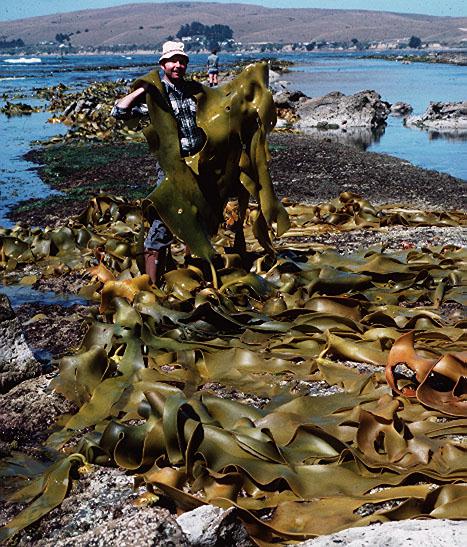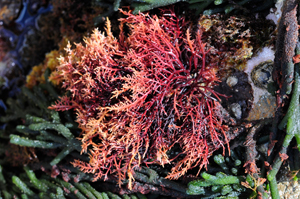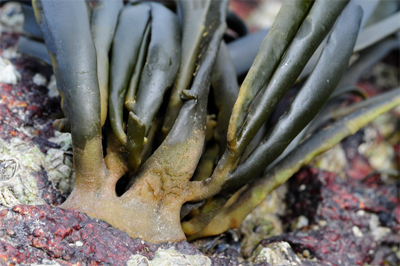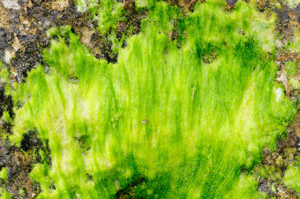What are seaweeds?
 Marine macroalgae, or seaweeds, are plant-like organisms that generally live attached to rock or other hard substrata in coastal areas. They belong to three different groups, empirically distinguished since the mid-nineteenth century on the basis of thallus color: brown algae (phylum Ochrophyta, class Phaeophyceae; see right for a large brown kelp, Durvillaea in New Zealand), red algae (phylum Rhodophyta; below Gelidium in Ireland), and
Marine macroalgae, or seaweeds, are plant-like organisms that generally live attached to rock or other hard substrata in coastal areas. They belong to three different groups, empirically distinguished since the mid-nineteenth century on the basis of thallus color: brown algae (phylum Ochrophyta, class Phaeophyceae; see right for a large brown kelp, Durvillaea in New Zealand), red algae (phylum Rhodophyta; below Gelidium in Ireland), and
green algae (phylum Chlorophyta, classes Bryopsidophyceae, Chlorophyceae,
Dasycladophyceae, Prasinophyceae, and Ulvophyceae; bottom, Ulva howensis in Lord Howe Island, off eastern Australia). Distinguishing these three phyla, however, involves more substantial differences than colour. In addition to the pigmentation, they differ considerably in many ultrastructural and biochemical features including photosynthetic pigments, storage compounds, composition of cell walls, presence/absence of flagella, ultrastructure of mitosis, connections between adjacent cells, and the fine structure of the chloroplasts. They originated through different evolutionary processes (primary endosymbiosis for green and red algae, secondary endosymbiosis for brown algae, and for this reason they are now classified in different kingdoms (green algae and red algae in the Kingdom Plantae, and brown algae in the Kingdom Chromista).
 Red and brown algae are almost exclusively marine, whilst green algae are also common in freshwater (rivers and lakes), and even in terrestrial (rocks, walls, houses, and tree bark in damp places) situations. Many of these algae are very ancient organisms, and although lumped together as "algae", are not really very closely related, having representatives in 4 of the 5 or 6 kingdoms of organisms.
Red and brown algae are almost exclusively marine, whilst green algae are also common in freshwater (rivers and lakes), and even in terrestrial (rocks, walls, houses, and tree bark in damp places) situations. Many of these algae are very ancient organisms, and although lumped together as "algae", are not really very closely related, having representatives in 4 of the 5 or 6 kingdoms of organisms.
Seaweeds are far more complex organisms than generally realised. Many have specialised tissues and growth forms. They may have very complicated sex, with many of them producing sex pheremones (chemicals that attract males or male gametes), and with many different types of sex organs. Red algae have the most complicated sex known in plants.  Kelps are known to have quite rapid translocation, something that is not credited to algae in many textbooks. There is even growing evidence of root-like structures in some wracks that reach deep into rocks, and which may be important in the "weathering" of rocks in the intertidal. Generally, seaweeds and many algae have holdfasts: basal structures that do exactly what the name suggests - hold fast to the rock. Seaweeds must produce some amazing adhesives as quite small holdfasts seem to be sufficient for quite large plants. On the right you can see the small holdfast (about 1 cm across) of an Ascophyllum nodosum (Egg Wrack) clump about 2 m in length.
Kelps are known to have quite rapid translocation, something that is not credited to algae in many textbooks. There is even growing evidence of root-like structures in some wracks that reach deep into rocks, and which may be important in the "weathering" of rocks in the intertidal. Generally, seaweeds and many algae have holdfasts: basal structures that do exactly what the name suggests - hold fast to the rock. Seaweeds must produce some amazing adhesives as quite small holdfasts seem to be sufficient for quite large plants. On the right you can see the small holdfast (about 1 cm across) of an Ascophyllum nodosum (Egg Wrack) clump about 2 m in length.

AlgaeBase dynamic species counts shows that there are about 11,000 species of seaweeds, of which 7,500 are red algae (Rhodophyta), 2,000 are browns and 1,500 are greens (about 800 species of Bryopsidophyceae, 50 species of Dasycladophyceae, 400 Siphoncladophyceae, and 250 marine Ulvophyceae. The most recent figures are given by AlgaeBase.
More information
- What are algae?
- Brown seaweeds (Ochrophyta, Phaeophyceae)
- Fucus (Wracks)
- Laminaria and Saccharina (Kelps)
- Green seaweeds (Chlorophyta, Chlorophyceae)
- Ulva (Sea Lettuce)
- Red seaweeds (Rhodophyta)
- Seaweeds of the north-eastern Atlantic (descriptions and pictures of many of the larger species).





